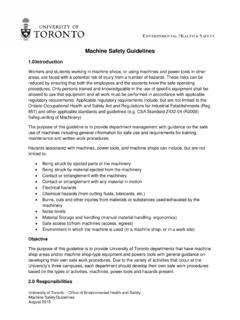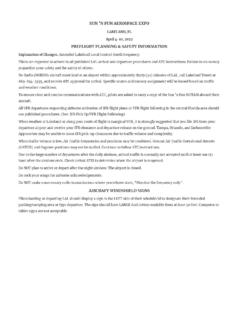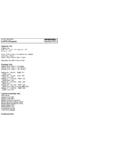Transcription of Guidelines for Working in Loading Docks
1 University of Toronto Office of Environmental Health and Safety Guidelines f or Working i n Loadi ng Docks June 2013 Page 1 of 8 Guideli nes fo r Wor king in Loading Docks INTRODUCTION Loading Docks are busy areas, where trucks, traile rs, pedestrians, lifting device s, and other equipment typical ly move throu ghout the area on a frequent basis. Serious or even f atal injuries can pote ntially be sustain ed fro m Loading dock h azard s su ch as: unsecur ed veh icles on moving on the dock, lift trucks tip-over or f all, and pedestrian co llision with lift trucks, falling loads, or tractor-tr aile rs.
2 Therefore, it is im portant to iden tify co mmon caus es o f Loading dock injuries and how to prevent typical h azard s tha t may be present in the dock ar ea. Loading dock h azards can include, but are not limited to: Im proper Loading and unloading pro cedur es ( load run-away, driv er pull-away, trailer cr eep, etc .) Sli ps, trips and falls Pedestrian Awareness and Vehicle Tra ffic Mate rials Handling and Lifting Devices ( forklifts) Stac king loads Ho usek eepi ngScope Th is guid eli ne a pplies to all University of T oro nto s taff who are required to be in and around Loading Docks during the course of their work.
3 It also a pplies to ex tern al w orkers or visitor s ( contractors, drivers, etc .) who may be required w ork in or access the University Loading doc ks. RESPO NSIBILITIES The roles and responsib ilities for management, supervisors and workers are documented below. Workers should re port con cerns to th eir supervisors and at any time, the Office of Environ men tal Heal th and Safety (EHS) can b e con tacted for a ssis tance or consu lta tion. Supervisor s/man agem ent/p rinciple investi gators Iden tify workers or work activ ities where workers may be required to be in Loading dock ar eas.
4 Iden tify and anticip ate the Loading dock h azard s th at may be presen t. Develop, document, implement an d maintain a ppropriate w ork pro cedures, m easures, i nspecti ons, a ndprecau tions to c ont rol the Loading dock h azard s th at may be present by using these Guidelines . Ensure that a Job Safety Analysis (JSA) or written w ork pro cedur e is completed where neces sary and that the yare r ead ily ava ilable to w orkers. Ensure controls identified in the JSA or other work pro cedur es are follow ed for safe work in Loading dock s.
5 Ensure that workers who are Working in Loading Docks are pro vid ed w ith the equipment, personal pro tectiv eequipment (PPE), appropr iate tr aining or other resources as iden tified by the JSA or other w ork pro cedures. Where work is contracted to e xtern al par ties, e quiv alent pro cedur es sh ou ld be followe Re port h ealth an d safet y ha zard s o r con cer ns, including an y unsafe Loading dock practices o r damagedequipment, to supervisors. Par ticip ate in a ppropriate tr aining to w ork safely in Loading Docks .
6 Review and be familiar with applicable J SA or other work pro cedur es bef ore s tart of work . Fo llow safety pro cedur es and use equipment and/or PPE as defined in the JSA or work pro cedur e. Wher e requested, a ssis t supervisors in identifying situations wit h pote ntial o f Loading dock h azard s a ndpar ticip ate in the development of the JSA or work pro cedur of Toronto Office of Environmental Health and Safety Guidelines f or Working i n Loadi ng Docks June 2013 Page 2 of 8 Office of Environm ental Health & S afety Provide consultation and assist in Loading dock m atte rs as needed.
7 Update an d maintain online tr ainin g module o n Loading Do ck Safety (EHS 549 Loading Do ck Safety ).Supervisors and workers may register via the EHS Training Registration website(http :// oront Training/EHSAR egistrati on ) Update and maintain these Guidelin es on a regu lar basis and/or when new information becomes availa GENER AL CONTROLS FO R Loading DOCK HAZARDS Cont rols for Working safely in l oading Docks and minimize Loading dock h azard s f all in to 4 categ ories: A. Eng ineering controlsB.
8 Administr ative controls a nd work pract icesC. Personal Protective Equi pm ent (PP E)D. Tra iningGener ally, the hierarchy of controls s tarts with engineering controls sin ce they have the ability to redu ce or elimin ate many Loading dock h azard s. The other cont rols d o not eli min ate or reduce the hazard but try to redu ce its imp act o n the w orker and pro vide workers with information to w ork safely in Loading dock s. A: Eng ineering Controls Vehicle Restraints Do ck P lates (Do ck Lev ele rs) Do ck Ba rrie rs and Bumpers Do ck D oors and SealsVehicle Restra ints Vehicle Restraints are required to be used to secure traile rs and vehicles wh ile Loading or unloading at dock.
9 Wh eel chocks are wedge-shap ed blocks that are p laced in front of the rear wheels of a t rai ler to prevent thetr ailer from moving away from the dock wh ile it is b eing loaded or unloaded. Attaching the chocks to theoutside of the dock or building will help k eep them nearby when needed. The length of the attac hmen tshould be long enough so the chocks can be used for di fferent sized veh icles. Ev en wi th wh eel chocks in place, the repeated up and down movement caus ed by Loading or unloadingacti vities, the surf ace conditions or the type of chock being used, can l oosen them and cause the trailer tomov e.
10 Some Loading Docks can have a restr aint s ystem that hooks onto the r ear imp act guard of a trailer ( ICCbar typ e, or other sim ilar m odels) which preven ts tr ailer cr eep and also preven ts individuals from drivin gaway before Loading or unloading is complete. Anoth er kind of restraint latch es on to the r ear wh eels of the trailer ( automatic wh eel t ype). These areuseful when the trailer is not equipped w ith a rear imp act guard or if it is bent or missing. For s potte d or dropped tr aile rs, the forward landing gear is sometimes r einf orced by using a portable j ackstand to keep the trailer from tipping forward.






